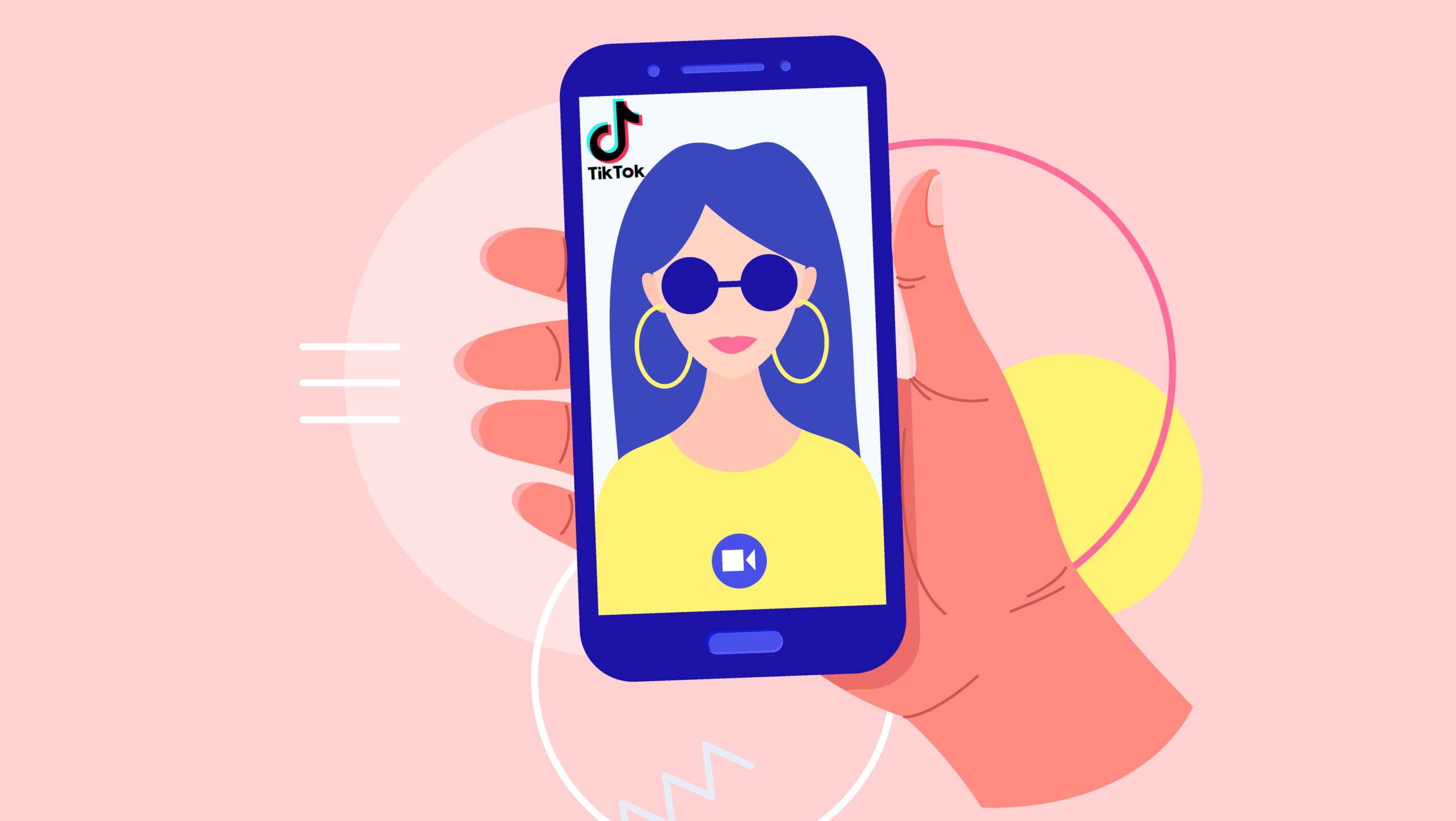For trans folks, having a conversation with a potential intimate partner about their transness can be anxiety-inducing. It’s not just a matter of vulnerability, but also safety. One way to process that anxiety? Take it to TikTok.
That’s what user @allisonxbeck did in a video in January, jokingly lip syncing to an audio sample of a Cardi B interview (“You know what, I was nervous for my second performance, for my first performance I was like, ah, party with Cardi”) to describe hooking up with a guy who doesn’t know she is trans. The video’s caption reads: “~ PSA: THIS IS A ~JOKE~ AND I WOULD ALWAYS LET A GUY KNOW IM TRANS IF I WERE TO BE WITH HIM.” The TikTok is sarcastic and obviously funny, but the medium allows that underlying anxiety to shine through, too.
TikTok—a social networking app that allows users to create and share short videos—has become a space (mostly young) people turn to make sense of their identities and the world around them. Or rather, it’s where they already are. It’s only natural, then, that the platform has transformed into a new way for them to express themselves in an endless variety of styles and contexts. Log on to the app today, for example, and you’ll find an onslaught of users joking about the COVID-19 pandemic—for good (criticizing the racist treatment of people of Asian descent in light of the crisis) or ill (taking part in that very racism).
Queer users have likewise been creating videos fuelled by political and social motives. In the U.S., a nihilistic meme that circulated on TikTok in late 2019 and early 2020 saw queer users roleplaying as visitors to Camp Pence—a darkly funny and tongue-in-cheek reference to Vice President Mike Pence’s support of conversion therapy.
@adee.ahI can’t wait l will do a vlog of it on my Youtube! ##trans ##fp ##foryou ##funny ##xmasballin ##lastminutexmas yes or no – user057744632
Trans TikTokers in particular make light of stereotypes while embracing their identities: Many use popular songs and sounds or trends to joke about how they are perceived by others. Others make their own versions of established memes, like this trans user who borrows the sound from a meme originally about privileged white girls making an anthem for themselves to make one about her own experience as a trans lesbian—a vulnerable assertion of self that also happens to be educational. Another popular video shows TikToker @adee.ah using questions posed in the Nicki Minaj song “Moment 4 Life,” interspersed with theatrical answers from another oft-memed video by Ebony Jenkins, to lightheartedly joke about their gender affirmation surgery.
LGBTQ2 youth have often turned to the internet to find community, or to discover spaces where they can be heard and acknowledged. For a long time, Tumblr served that purpose: A place where millions of queer and trans youth could experiment with their identities and be themselves. YouTube also became a major resource, with countless users on the platform looking for others to relate to and connect with. TikTok is the latest digital space where LGBTQ2 youth are congregating, and the audience is bigger than ever: Nearly a billion monthly active users are on the app, far more than Tumblr ever had. The platform may look as though it’s made solely for memes and mindless entertainment. But if you look closely, you’ll find marginalized groups carving out space for themselves and taking advantage of an online space for their own queer interests; TikTok is where they can address the hard stuff and the weird stuff in short, relatable bursts.
“The platform has transformed into a new way for young people to express themselves in an endless variety of styles and contexts”
What most of these videos have in common is that their creators have an intuitive understanding of TikTok’s operation and structure. All social media platforms have specific affordances within their design and policies that help users navigate them in specific ways. Twitter, for example, is unique in its refusal to allow its users to edit tweets, so people are encouraged to be more careful before posting. Until a ban in December 2018, Tumblr was known for its leniency toward nudity. But TikTok is its own beast: While it imports the logic of lip-sync app musical.ly (which TikTok’s owner, ByteDance, specifically bought to merge with its existing app called Douyin) and the humour and meme-ability of Vine, it has also created its own assemblage of shared resources, including platform-specific memes, emotions and hashtags. Powered by repetition and personalization, TikTok’s network encourages users to find inventive ways to get noticed. The most basic example is including hashtags like #fyp or #foryou in your post to help get it placed in the main “For You” feeds of other users. But even more effective is a nuanced knowledge of how memes circulate on the platform: The more a meme is repeated and recreated, the more value is attached to it, and the easier it becomes for other users to hijack and exploit that meme.
And LGBTQ2 users take that into account. Queer users, for example, often insert surprising observations or even uncomfortable truths where you would have expected the formulaic punchline of a familiar meme.
@spiritwildcat1983Having a little fun…##auntyspirit ##twospirit ##native ##lgbtq ##queen ##spiritwildcat ##fyp Stadium Pow Wow – A Tribe Called Red
One common trend on TikTok is “the transformation.” Set to a clip of Britney Spears’ “…Baby One More Time,” some users, for example, reveal their makeup makeovers—ranging from dramatically elaborate rainbows covering one girl’s entire face and upper body, to some surprise Mulan cosplay. Two-Spirit users in both Canada and the U.S. have created their own version, usually set to various songs by A Tribe Called Red. Some are, like the makeup makeovers, focused on the visual evolution. Others take the opportunity to exhibit all sides of their identity, donning new outfits with the swipe of a brush against the camera. Many get creative and infuse their videos with humour: Makeup brushes drop from out of nowhere, inspiring a sudden outfit montage. And still others use familiar sounds—like a snippet from Cinderella’s “Bibbidi-Bobbidi-Boo”—to give the trend their own spin.
These TikTokers find community with other Two-Spirit folks on the app, even making jokes about the reception they can get from ignorant commenters on their videos. They also share a keen awareness of how memes circulate on TikTok, playing into popular formats to make their voices heard.
But there are more pointedly political—and even instructional—videos, created by users interested in having a larger impact. For instance, @ohkairyn makes videos like this one, in which he explains what Two-Spirit means, in great detail, while applying makeup. Or this one, where he jokingly says his greatest achievement is not losing his virginity to a white guy. And because it’s so common for TikTokers to use songs or already-memed snippets of sound in their videos, it’s even more significant when someone uses their voice to make personal statements.
@ohkairynmy greatest achievement. this two-spirit temple remains untouched by settlers ##indigenous ##twospirit ##nativetiktok ##humor original sound – ohkairyn
Another Two-Spirit user, @blackbirdpauwau, uploaded a video last month with reams of text about the epidemic of missing and murdered Indigenous women, girls and Two-Spirit folks. Anyone that comes across it has to repeatedly pause the video in order to read it. He tells his own story of being a homeless kid, who was kidnapped and tortured, which he says happened because he is Two-Spirit. “Leaving us out of the conversation of missing and murdered literally kills us,” he writes. “It’s one thing to go through this experience; it’s another to come out the other side and [have] my experience be invalidated because I am not a girl. We can’t keep forgetting our trans/Two-Spirit relatives who are suffering alone in this epidemic.” He says that if he survived for any reason, it’s to educate others and fight for justice.
Is it possible to make a real difference through memes and makeover videos? Many users on TikTok seem caught in this tension, pulled between the creative freedom and tools at their disposal on the platform and the control levied by its algorithmic power. If every utterance online is scrubbed for data points, how can anyone make an impact?
TikTok videos are often considered trivial, frivolous, ephemeral. And they often are those things, but that doesn’t mean that they don’t say something more substantial. Their power grows with repetition and rhythm. And if the last few years have shown us anything about the internet, it’s that memes can alter the shape of our lives. It’d be a mistake to ignore their force, especially when it can be weaponized to make a meaningful difference.
Watching videos like those on TikTok serves as a reminder that, however you choose to make yourself known, someone is watching. There are strategies for capturing the moment in a way that subverts expectations—and, whether or not change happens, at least there’s potential in that.


 Why you can trust Xtra
Why you can trust Xtra


